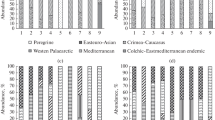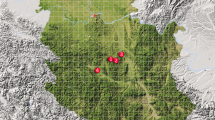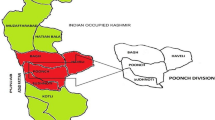Abstract—
According to the results of 9 years of earthworm collections in soil in Omsk oblast from 2009 to 2018, their population has been analyzed in order to identify the main environmental factors associated with the territorial heterogeneity of species richness and group density. Five types of Lumbricidae populations have been identified, two of which are divided into two subtypes, where ten species and two subspecies of earthworms are found. It has been established that environmental factors such as zonality and subzonality; the depth of the soil layer; and, to a lesser extent, the topography characteristics have the greatest influence on the distribution of worms: 9, 7, and 0.7% of the considered variance of the density similarity matrix, respectively. In general, all environmental factors and their combinations (modes) explain 38% of the considered variance; the multiple correlation coefficient is 0.62. Dendrobaena octaedra (7–52%) and Aporrectodea caliginosa (15–74%), alien species of European origin, and the native Eisenia n. nordenskioldi (6–28%) took over in terms of the share of the population density in most taxa of the classification, as well as Eisenia ventripapillata (42%) and E. nana (16%) of Asian origin, for the territories of the southern forest steppe and steppe. Such changes in earthworm populations, namely the replacement of native species of the Eisenia nordenskioldi complex with alien species, can significantly affect soil characteristics and ecosystem services determined by earthworms.


Similar content being viewed by others
REFERENCES
Akulova, L.I., Dolgin, M.M., and Kolesnikova, A.A., Distribution and abundance of earthworms (Lumbricidae) in the middle taiga subzone of the Komi Republic, Vestn. Inst. Biol. Komi Nauchn. Tsentra Ural. Otd. Ross. Akad. Nauk, 2017, vol. 1, no. 199, pp. 4–16
Babiy, K.A., Kniazev, S.Yu., Golovanova, E.V., and Abramenko, A.S., Influence of exotic Eisenia nana (Opisthopora, Lumbricidae) on the cationic composition of three types of soils in south Western Siberia (experiment in microcosms), Russ. J. Ecosyst. Ecol., 2021а, vol. 6, no. 3, pp. 1–12.
Babiy, K.A., Kniazev, S.Yu., Golovanova, E.V., Solomatin, D.V., and Bel’skaya, L.V., What determines ion content of lumbricid casts: soil type, species, or ecological group?, Polish J. Ecol., 2021b, vol. 69, no. 2, pp. 96–110.
Bengtson, S.A., Nilsson, A., Nordström, S., and Rundgren, S., Shortterm colonizaton success of Lumbricid founder populatons, Oikos, 1979, vol. 33, pp. 308–315.
Berman, D.I. and Leirikh, A.N., The ability of the earthworm Eisenia nordenskioldi (Eisen) (Lumbricidae, Oligochaeta) to tolerate negative temperatures, Dokl. Akad. Nauk SSSR, 1985, vol. 285, no. 5, pp. 1258–1261.
Berman, D.I., Leirikh, A.N., and Alfimov, A.V., On tolerance of earthworm Eisenia nordenskioldi (Oligochaeta, Lumbricidae) for extremely low soil moisture in the northeast of Asia, Zool. Zh., 2002, vol. 81, no. 11, pp. 1308−1318.
Berman, D.I., Leirikh, A.N., and Meshcheryakova, E.N., Distribution and cold tolerance of earthworms in the northeastern and eastern Europe, Tezisy dokladov III (XIII) Vserossiiskogo soveshchaniya po pochvennoi zoologii “Problemy pochvennoi zoologii” (Proc. III (XIII) All- Russ. Conf. on Soil Zoology “Problems of Soil Zoology”), Yoshkar-Ola, 2002, pp. 24–25.
Berman, D.I., Meshcheryakova, E.N., Alfimov, A.V., and Leirikh, A.N., Spread of the earthworm Dendrobaena octaedra (Lumbricidae: Oligochaeta) from Europe to Northern Asia is restricted by its insufficient frost resistance, Dokl. Biol. Sci., 2001, vol. 377, pp. 145–148.
Berman, D.I., Meshcheryakova, E.N., and Leirikh, A.N., Egg cocoons of the earthworm Dendrodrilus rubidus tenuis (Lumbricidae, Oligochaeta) withstand the temperature of liquid nitrogen, Dokl. Biol. Sci., 2010, vol. 434, no. 1, pp. 347–350.
Bessolitsyna, E.P., Landscape-ecological patterns of earthworm (Oligochaeta, Lumbricidae) distribution in the soils of Southern Middle Siberia, Contemp. Probl. Ecol., 2013, vol. 18, no. 1, pp. 27–36.
Blouin, M., Hodson, M.E., Delgado, E.A., Baker, G., Brussaard, L., Butt, K.R., et al., A review of earthworm impact on soil function and ecosystem services, Eur. J. Soil Sci., 2013, vol. 64, pp. 161−182.
Bulatov, V.I., Landscapes, in Atlas Omskoi Oblasti (Atlas of the Omsk region), Omsk: Omsk. Kartogr. Fabrika, 1999.
Callaghan, T.V., Shaduyko, O., Kirpotin, S.N., et al., Siberian environmental change: Synthesis of recent studies and opportunities for networking, Ambio, 2021, vol. 50, no. 6, pp. 2104−2127.
Capowiez, Y., Bottinelli, N., Sammartino, S., Michel, E., and Jouquet, P., Morphological and functional characterisation of the burrow systems of six earthworm species (Lumbricidae), Biol. Fertil. Soils, 2015, vol. 51, no. 7, pp. 869–877.
Chen, L., Aalto, J., and Luoto, M., Significant shallow-depth soil warming over Russia during the past 40 years, Global Planet. Change, 2021, vol. 197, art. ID 103394.
Curry, J.P. and Schmidt, O., The feeding ecology of earthworms—A review, Pedobiologia, 2007, vol. 50, no. 6, pp. 463–477.
Decaëns, T., Margerie, P., Renault, J., Bureau, F., Aubert, M., and Hedde, M., Niche overlap and species assemblage dynamics in an ageing pasture gradient in north-western France, Acta Oecol., 2011, vol. 37, no. 3, pp. 212–219.
Dymond, P., Scheu, S., and Parkinson, D., Density and distribution of Dendrobaena octaedra (Lumbricidae) in aspen and pine forests in the Canadian Rocky Mountains (Alberta), Soil Biol. Biochem., 1997, vol. 29, nos. 3–4, pp. 265–273.
Eggleton, P., Inward, K., Smith, J., Jones, D.T., and Sherlock, E., A six year study of earthworm (Lumbricidae) populations in pasture woodland in southern England shows their responses to soil temperature and soil moisture, Soil Biol. Biochem., 2009, vol. 41, no. 9, pp. 1857–1865.
Ermolov, S.A., Earthworm communities (Oligochaeta, Lumbricidae) of pine forests and small foliage forests in the forest-steppe Ob’ region, Vopr. Les. Nauki, 2020, vol. 3, no. 2, pp. 1−24.
Felten, D. and Emmerling, C., Earthworm burrowing behaviour in 2D terraria with single-and multi-species assemblages, Biol. Fert. Soils, 2009, vol. 45, no. 8, pp. 789–797.
Fourcade, Y. and Vercauteren, M., Predicted changes in the functional structure of earthworm assemblages in France driven by climate change, Diversity Distrib., 2022, vol. 28, no. 5, pp. 1050−1066.
Frelich, L.E., Hale, C.M., Scheu, S., Holdsworth, A.R., Heneghan, L., Bohlen, P.J., Reich, P.B., Earthworm invasion into previously earthworm-free temperate and boreal forests, Biol. Invasion, 2006, vol. 8, pp. 1235–1245.
Frenot, Y., Introduced populations of Dendrodrilus rubidus ssp. (Oligochaeta:Lumbricidae) at Crozet, Kerguelen and Amsterdam islands: effects of temperature on growth patterns during the juvenile stages, Soil Biol. Biochem., 1992, vol. 24, no. 12, pp. 1433–1439.
Geraskina, A.P., The population of earthworms (Lumbricidae) in the main types of dark coniferous forests in Pechora-Ilych Nature Reserve, Biol. Bull., 2016, vol. 43, no. 8, pp. 819–830.
Gilarov, M.S., Measurement of large soil invertebrates (mezofauna), Kolichestvennye metody v pochvennoi zoologii (Quantitative Methods in Soil Zoology), Moscow: Nauka, 1987, pp. 9–26.
Golovanova, E.V., The earthworms of Omsk region, Tr. Tomsk. Gos. Univ., Ser. Biol., 2010, vol. 275, pp. 111–113.
Golovanova, E.V., Alien species of earthworms in Western Siberia, Materialy Mezhdunarodnogo sympoziuma “Ekologiya i evolutsiya: novye gorizonty” (Proc. Int. Symp. “Ecology and Evolution: New Challenges”), Ekaterinburg: Gumanit. Univ., 2019, pp. 494–495.
Golovanova, E.V., Knyazev, S.Yu., Babiy, K.A., and Tsvirko, E.I., Distribution of alien earthworms species Aporrectodea caliginosa in natural habits of the Omsk region, Sbornik nauchnykh trudov konferentsii “Poznaniye i deyatel’nost’: ot proshlogo k nastoyashchemu” (Proc. Conf. “Knowledge and Activity: from Past to Present”), Omsk: Omsk. Gos. Pedagog. Univ., 2020, pp. 299–302.
Golovanova, E.V., Kniazev, S.Yu., Babiy, K.A., Tsvirko, E.I., Karaban, K., Solomatin, D.V., Dispersal of earthworms from the Rudny Altai (Kazakhstan) into Western Siberia, Ecol. Montenegrina, 2021, vol. 45, pp. 48–61.
Holmstrup, M. and Overgaard, J., Freeze tolerance in Aporrectodea caliginosa and other earthworms from Finland, Cryobiology, 2007, vol. 55, no. 1, pp. 80–86.
Hopkins, J.J., Allison, H.M., Walmsley, C.A., Gaywood, M., and Thurgate, G., Conserving biodiversity in a changing climate: guidance on building capacity to adapt, in Department for Environment. Food and Rural Affairs, London, 2007.
Jiménez, J.J. and Decaëns, T., Vertical distribution of earthworms in grassland soils of the Colombian “Llanos”, Bio-l. Fertil. Soils, 2000, vol. 32, no. 6, pp. 463–473.
Johnston, A.S.A., Holmstrup, M., Hodson, M.E., Thorbek, P., Alvarez, T., and Sibly, R.M., Earthworm distribution and abundance predicted by a process-based model, Appl. Soil Ecol., 2014, vol. 84, pp. 112–123.
Jones, C.G., Lawton, J.H., and Shachak, M., Organisms as ecosystem engineers, Oikos, 1994, vol. 69, no. 3, pp. 373–386.
Jouquet, P., Blanchart, E., and Capowiez, Y., Utilization of earthworms and termites for the restoration of ecosystem functioning, Appl. Soil Ecol., 2014, vol. 73, pp. 34–40.
Kirpotin, S.N., Callaghan, T.V., Peregon, A.M., et al., Impacts of environmental change on biodiversity and vegetation dynamics in Siberia, Ambio, 2021, vol. 50, no. 11, pp. 1926−1952.
Kolesnikova, A.A., Baturina, M.A., Shadrin, D.M., Konakova, T.N., and Taskaeva, A.A., Newrecords of Lumbricidae and Collembola in anthropogenic soils of East European tundra, ZooKeys, 2019, vol. 885, no. 199, pp. 15–25.
Lavelle, P., Spain, A., Blouin, M., Brown, G., Decaens, T., Grimaldi, M., Jimenez, J.J., McKey, D., Mathieu, J., Velasquez, E., and Zangerle, A., Ecosystem engineers in a self-organized soil: a review of concepts and future research questions, Soil Sci., 2016, vol. 181, no. 3/4, pp. 91–109.
Leirikh, A., Meshcheryakova, E., and Berman, D., The mechanism of cold hardiness of egg cocoons of the earthworm Dendrobaena octaedra (Sav.) (Lumbricidae: Oligochaeta), Dokl. Biol. Sci., 2004, vol. 398, pp. 385–387.
Makarova, O.L. and Kolesnikova, A.A., Earthworms (Oligochaeta, Lumbricidae) in the Tundra of Eastern Europe, Biol. Bull., 2019, vol. 46, pp. 438–449.
Martin, S. and Lavelle, P., A simulation model of the vertical movements of an earthworm population (Millsonia anomala, Omodeo, Megascolecidae) in an African savanna (Lamto, Ivory Coast), Soil Biol. Biochem., 1992, vol. 24, no. 12, pp. 1419–1424.
McDaniel, J.P., Stromberger, M.E., Barbarick, K.A., and Cranshaw, W., Survival of Aporrectodea caliginosa and its effects on nutrient availability in biosolids amended soil, Appl. Soil Ecol., 2013, vol. 71, pp. 1–6.
Meshcheryakova, E.N. and Berman, D.I., Cold hardiness and geographic distribution of earthworms (Oligochaeta, Lumbricidae, Moniligastridae), Entomol. Rev., 2014, vol. 94, no. 4, pp. 486–497.
Millican, D.S. and Lutterschimdt, W.I., Comparative seasonal observations of soil temperature and moisture and the occurrence of two earthworms inhabiting prairie and deciduous woodland sites, Southwest. Nat., 2007, vol. 52, no. 4, pp. 468–474.
Najar, I.A., Khan, A.B., and Hai, A., Occurrence of the Aporrectodea caliginosa caliginosa (Savigny, 1826) (Annelida: Clitellata: Haplotaxida) from Kashmir Valley, Jammu & Kashmir, India J. Threatened Taxa, 2020, vol. 12, no. 15, pp. 17138–17146.
Naumov, R.L., Birds of the natural focus of tick-borne encephalitis in the Krasnoyarsk Territory, Extended Abstract of Cand. Sci. (Biol.) Dissertation, Moscow: Mosk. Obl. Pedinst., 1964.
Perel, T.S., Distribution and distribution patterns of earthworms of the fauna of the USSR, Moscow: Nauka, 1979.
Perel, T.S., Specific features of the earthworm fauna (Oligochaeta, Lumbricidae) in Altai refugia of nemoral vegetation, Dokl. Akad. Nauk SSSR, 1985, vol. 283, no. 3, pp. 752–756.
Pérez-Losada, M., Ricoy, M., Marshall, J. C., and Domínguez, J., Phylogenetic assessment of the earthworm Aporrectodea caliginosa species complex (Oligochaeta: Lumbricidae) based on mitochondrial and nuclear DNA sequences, Mol. Phylogenet. Evol., 2009, vol. 52, no. 2, pp. 293–302.
Phillips, H.R., Guerra, C.A., Bartz, M.L., Briones, M.J., Brown, G., Crowther, T.W., and Orgiazzi, A., Global distribution of earthworm diversity, Science, 2019, vol. 366, no. 6464, pp. 480–485.
Ravkin, Yu.S. and Livanov, S.G., Faktornaya zoogeografiya (Factor Zoogeography), Novosibirsk: Nauka, 2008.
Ravkin, Yu.S., Kupershtokh, V.L., and Trofimov, V.A., Spatial organization of the bird population, in Ptitsy lesnoi zony Priob’ya (Birds of the Forest Zone of the Ob Region), Novosibirsk: Nauka, 1978, pp. 253–269.
Sergeev, M.G., Striganova, B.R., Mordkovich, V.G., Molodtsov, V.V., Nikolaeva, O.N., and Bogomolova, I.N., Spatial-typological differentiation of ecosystems of the west siberian plain. Communication III: Terrestrial invertebrates, Contemp. Probl. Ecol., 2011, vol. 4, art. ID 347.
Shekhovtsov, S.V., Golovanova, E.V., and Peltek, S.E., Different dispersal histories of lineages of the earthworm Aporrectodea caliginosa (Lumbricidae, Annelida) in the Palearctic, Biol. Invasions, 2016, vol. 18, no. 3, pp. 751–761
Shekhovtsov, S.V., Golovanova, E.V., Bazarova, N.E., B-elova, Y.N., Berman, D.I., Derzhinsky, E.A., Shashkov, M.P., and Peltek, S.E., Genetic diversity of the Aporrectodea caliginosa complex in Russia, Vavilovskii Zh. Genet. Sel., 2017, vol. 21, no. 3, pp. 374–379.
Strignova, B.R. and Poryadina, N.M., Zhivotnoe naselenie pochv boreal’nykh lesov Zapadno-Sibirskoi ravniny (Animal Population of Soils in Boreal Forests of the West-Siberian Plain), Moscow: KMK, 2005.
Tiunov, A.V., Hale, C.M., Holdsworth, A.R., and Vsevolodova-Perel, T.S., Invasion patterns of Lumbricidae into the previously earthworm-free areas of northeastern Europe and the western Great Lakes region of North America, Biol. Invasions, 2006, vol. 8, pp. 1223–1234.
Trofimov, V.A., Models and methods of qualitative factor analysis of the coupling matrix, Problemy analyza diskretnoi informatsii (Problems of Analysis of Discrete Information), Novosibirsk, 1976, vol. 2, pp. 24–36.
Trofimov, V.A. and Ravkin, Yu.S., Express method for assessing the relationship between the spatial heterogeneity of the animal population and environmental factors, Kolichestvennye metody v ekologii zhivotnykh (Quantitative Methods in Animal Ecology), Leningrad: Nauka, 1980, pp. 113–115.
Trofimova, I.E. and Balybina, A.S., Regionalization of the West Siberian Plain from thermal regime of soils, Geogr. Nat. Resour., 2015, vol. 36, pp. 234–244.
Vorobeichik, E.L., Ermakov, A.I., Nesterkova, D.V., and Grebennikov, M.E., Coarse woody debris as microhabitats of soil macrofauna in polluted areas, Biol. Bull., 2020, vol. 47, pp. 87–96.
Vsevolodova-Perel, T.S., Dozhdevye chervil fauny Rossii: Kadastr I opredelitel’ (Earthworms in Russian Fauna: Cadastre and Guide for Identification), Moscow: Nauka, 1997.
Vsevolodova-Perel, T.S. and Leirikh, A.N., Distribution and ecology of the earthworm Eisenia nordenskioldi pallida (Oligochaeta, Lumbricidae) dominant in southern Siberia and the Russian Far East, Entomol. Rev., 2014, vol. 94, no. 4, pp. 479–485.
Walsh, C.L. and Johnson-Maynard, J.L., Earthworm distribution and density across a climatic gradient within the Inland Pacific Northwest cereal production region, Appl. Soil Ecol., 2016, vol. 104, pp. 104–110.
Yang, H., Zhou, J., Feng, J., Zhai, S., Chen, W., Liu, J., and Bian, X., Ditch-buried straw return: A novel tillage practice combined with tillage rotation and deep ploughing in rice-wheat rotation systems, Adv. Agron., 2019, vol. 154, pp. 257–290.
Zapadnaya sibir’ (Western Siberia), Richter, G.D., Ed., Moscow: Akad. Nauk SSSR.
Zorn, M.I., van Gestel, C.A.M., Morrien, E., Wagenaar, M., and Eijsackers, H., Flooding responses of three earthworm species Allolobophora chlorotca, Aporrectodea caliginosa and Lumbricus rubellus, in a laboratory-controlled environment, Soil Biol. Biochem., 2008, vol. 40, no. 3, pp. 587–593.
ACKNOWLEDGMENTS
We are grateful to Y.S. Ravkin for analyzing the manuscript and making valuable comments.
Funding
This study was supported by the Russian Science Foundation (grant no. 22-14-20034).
Author information
Authors and Affiliations
Corresponding author
Ethics declarations
Conflict of interests. The authors declare that they have no conflicts of interest.
Statement on the welfare of animals. All applicable international, national, and/or institutional guidelines for the care and use of animals were followed.
Additional information
Translated by N. Ruban
Rights and permissions
About this article
Cite this article
Kniazev, S.Y., Kislyi, A.A., Bogomolova, I.N. et al. Territorial Heterogeneity of the Earthworm Population (Opisthopora, Lumbricidae) of Omsk Oblast and Environmental Factors: A Quantitative Assessment of the Relationship. Contemp. Probl. Ecol. 15, 484–493 (2022). https://doi.org/10.1134/S1995425522050079
Received:
Revised:
Accepted:
Published:
Issue Date:
DOI: https://doi.org/10.1134/S1995425522050079




